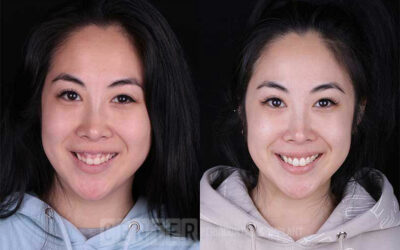Revolutionizing Gum Disease Treatment: A Non-Surgical Approach to Healing at the Microscopic Level
Gum disease is a widespread oral health issue that affects millions of people around the world. Left untreated can cause tooth loss, receding gums, and other serious complications. Our dental office has witnessed the negative impact of gum disease on our patient’s oral health and overall quality of life. In the past, treatment for gum disease often involved invasive surgery. However, today, there are non-surgical options available that can effectively address the root cause of periodontal disease using a medical approach borrowed from gastroenterology. This blog post will discuss the benefits of a non-surgical approach to gum disease treatment and introduce you to some of the most effective methods for healing your gums without surgery by applying a medical approach to a dental problem.
But I Brush and Floss and Still Have Gum Disease
Despite the common belief that poor oral hygiene is the leading cause of gum disease, we often see patients who have good oral hygiene habits but still develop periodontal disease. This raises the question: why do some people get gum disease even with proper oral care? To understand this, it’s important to examine the relationship between oral health, gum disease, and the body’s overall health. We will delve deeper into this relationship and explore the various factors that can contribute to the development of gum disease.
Understanding the Relationship Between Oral Health, Gum Disease, and the Body
Periodontal disease, or gum disease, is an infectious disease caused by bacteria, viruses, and parasites that colonize the pockets between teeth and gums, leading to tissue destruction. This destruction occurs through the release of toxins created by the immune system’s response to the bacteria and through the release of immunological byproducts that can affect organs like the heart, liver, and kidneys. Therefore, it is vital to understand the relationship between the oral cavity and the rest of the body to treat gum disease effectively.
The Role of Viruses and Oral Parasites in Gum Disease
Many patients come to us with symptoms such as bleeding gums, ulcerations, and fever but are unsure of the cause. So we educate our patients on the fact that gum disease is not just a bacterial concern but can also be caused by viruses and parasites.
While bacteria are the most common cause of gum disease, viruses and parasites can also play a role in the development of the condition. For instance, the herpes simplex virus, which is known for causing cold sores, can also contribute to gum disease. This virus, along with the immune system’s inflammatory response, can trigger the destruction of periodontal tissue.
Destructive periodontal disease is often linked to certain types of oral parasites, such as Entamoeba gingivalis, Trichomonas tenax, and Candida spp. These parasites can cause severe damage to the gums and other parts of the mouth. Therefore, it’s vital that the dentist or periodontist treating you be aware of these parasites and treat them appropriately, so the issues don’t continually reoccur.
The Role of the Immune System in Gum Disease
So now that you understand that bacteria, viruses, and parasites can cause gum disease, what about the immune system’s response to these invaders? When bacteria, viruses, and parasites settle between teeth and gums, the immune system launches an inflammatory response that damages the periodontal tissue. Unfortunately, this process also involves the release of pro-inflammatory cytokines and the activation of matrix metalloproteinase and osteoclasts, which can contribute to the progression of gum disease.
The Relationship Between Oral Parasites and Maturing Dental Plaque
Bacteria in dental plaque can lead to irritation and inflammation in the gums, creating an ideal environment for parasites to thrive. This can result in the development of destructive periodontal disease. Once established, these parasites can dominate the area around the teeth and gums and can be challenging to eliminate. Therefore, understanding the various local and systemic factors contributing to this process is essential for preventing and treating gum disease.
The Non-Surgical Approach to Treating Gum Disease at Our Clinic
It is crucial for patients to be aware of the full range of causes of gum disease in order to receive the most effective treatment. A dentist or periodontist can help to diagnose gum disease and apply a traditional approach to treating periodontal disease using a standard set of steps, beginning with a deep cleaning to reduce inflammation and infection, followed by additional maintenance treatments if necessary, and regular follow-up appointments. While this method can effectively manage the disease, it does not fully cure it.
The periodontists at our Los Angeles, CA clinic, Dr. Aalam and Dr. Krivitsky, take a non-surgical approach to diagnosing, treating, and curing gum disease before surgical procedures are considered. Therefore, each patient is unique, as is the treatment we choose to address their periodontal issues.
At our office, we use a microscope to diagnose and monitor the progress of gum disease, allowing us to take a medical approach to a dental problem and tailor treatment to each individual patient’s needs.
The Benefits of a Non-Surgical Approach to Gum Disease Treatment
By examining plaque under a microscope, we can identify a patient’s specific type of gum disease and understand how it relates to their overall health. Then during every patient visit, we take a sample of the parasites, viruses, and bacteria present in their mouth and examine it under a microscope. We track the changes in these organisms over time and adjust the treatment protocol as necessary to ensure the best possible outcome. This approach allows us to continuously evaluate the effectiveness of treatment and make necessary adjustments.
Through a series of 10 office visits and strict home care protocols, including techniques taught and medications prescribed, we are able to not only understand the disease but also control inflammation and infection at a microscopic level and cure the gum disease at its most crucial point. Using this unique medical approach, we can provide ongoing personalized treatment that takes into account the unique characteristics of the patient’s gum disease and overall health as the treatment progresses.
Using microscopy allows us to track and educate patients on their treatment progress. The patient and the provider can see the examination results under the microscope. Based on what we find, we may adjust medication delivery or home care protocols to improve the patient’s overall gum health.
The Importance of Proactive Oral Health Care for Managing and Curing Gum Disease
With our innovative non-surgical therapy, we help our patients take responsibility for their oral care and support their body’s natural ability to heal from gum disease. This approach allows us to build bone and improve overall gum health.
It is important for patients to be proactive in their oral health care and to see a dentist or periodontist regularly to diagnose and treat gum disease before it progresses. With the right treatment plan, it is possible to successfully not only manage but cure gum disease and maintain good oral health.
Non-Surgical Approaches to Gum Disease Treatment: Achieving the Best Possible Outcomes
Gum disease is a common oral health issue that can have serious consequences if not treated. At The Center for Advanced Periodontal & Implant Therapy, we offer a range of non-surgical approaches to gum disease treatment that effectively address the root cause of the condition using a medical approach borrowed from gastroenterology. By understanding the relationship between oral health, gum disease, and the body, we can customize treatment to meet each patient’s specific needs and achieve the best possible outcomes. If you are experiencing gum disease, we encourage you to reach out to us to learn more about the non-surgical treatment options available at our Brentwood, CA, practice.
You May Also Like...
Understanding the Microbiome of the Mouth: Why Balance Matters for Gum Health
We often think of brushing, flossing, and regular cleanings as the cornerstones of oral health. But beneath these...
The Real Cure for Periodontitis: Dispelling Myths About Gum Disease Treatment
Periodontitis, commonly known as gum disease, has long been regarded as a chronic condition that can only be managed,...
Gum Overgrowth and the Causes Behind Gums Growing Over Teeth
At The Center for Advanced Periodontal & Implant Therapy in Los Angeles, CA, we know how difficult it can be to...



